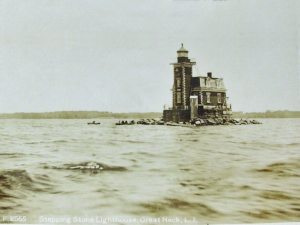
(From the collection of Alice Kasten)
One day, this historic building will illuminate visitors
By Alice Kasten
Stepping Stones Lighthouse has guarded the Long Island Sound entrance to New York Harbor since 1876. Constructed to warn mariners of a shoal of rocks that extends out into the Sound, the lighthouse is located between Kings Point and City Island on top of 900 tons of boulders that were moved to that location to provide a foundation. The waters surrounding Stepping Stones are very tricky. While the deepest waters in the area are just north of the lighthouse, the depths to the south are as shallow as three feet. Without the assistance of the lighthouse, many more boats would suffer damage from the rocks than do today.

The lighthouse actually looks like a house—and functioned as one, too. The basically square structure, measuring about 26 feet on each side, was built in a style called Second Empire and is made of brick with a mansard roof. The original plans called for a kitchen, sitting room, dining room and oil room on the first floor, and four bedrooms on the second floor. As in many buildings of the day, there was no bathroom. Stepping Stones was occupied by a succession of lighthouse keepers and their families. The keeper job was a family affair; the lamp had to be kept full of oil and the glass continually cleaned. Rowing to the mainland for supplies might occupy some family members, while others performed chores to keep the light strong. Although technically closer to Great Neck, the families of the lighthouse always had a strong tie to City Island in the Bronx. The children of the lighthouse attended school on City Island and supplies came from there as well.

Renovations were made in the 1940s. But in 1964 when the light was automated by the Coast Guard, there was no longer a need for a
keeper to be on location full time. The original light is currently on display at the Merchant Marine Academy Museum, but the fog bell, which sounded when the light could not be seen, has gone missing.
Although the Coast Guard is responsible for the operation of the light, it can no longer afford to maintain the structure of the lighthouse. In 2006, the Town of North Hempstead applied for and was granted stewardship of the building, with a charge to maintain and improve the decaying condition of the lighthouse. In an effort to make the rehabilitation a reality, in 2014, the town partnered with the Great Neck Historical Society and the Great Neck Park District in a unique public/private association.

Their goal is to not only repair the crumbling foundation, masonry, roof and interior damage, but to restore the inside features, and create an understanding of the lighthouse’s role as well as the role of its hardworking keepers in the rugged, often unfriendly, environment. Hopefully, groups will be able to visit the lighthouse one day to learn about its integral role in the life of the harbor. It will become a museum of a life gone by, and a wonderful educational resource for little ones.
In fact, a group of children are taking the lead in learning about and donating to the restoration effort. The students of John F. Kennedy Elementary School in Kings Point have adopted the lighthouse, pooled their money, made models and publicized the plight of the structure.
But so much more help is needed. The engineer’s report indicates that restoring the lighthouse could cost approximately $4 million. The town has applied for grants and the park district and historical society are attempting to raise awareness—and funds. To view a video that the town produced to capture the feel and highlight the needs of the lighthouse, go to YouTube and type in Stepping Stones Lighthouse. For more information or to support the lighthouse, visit the Great Neck Historical Society at www.greatneckhistorical.org.
Alice Kasten is president of the Great Neck Historical Society.
To read our beautiful Great Neck Magazine, click here.































